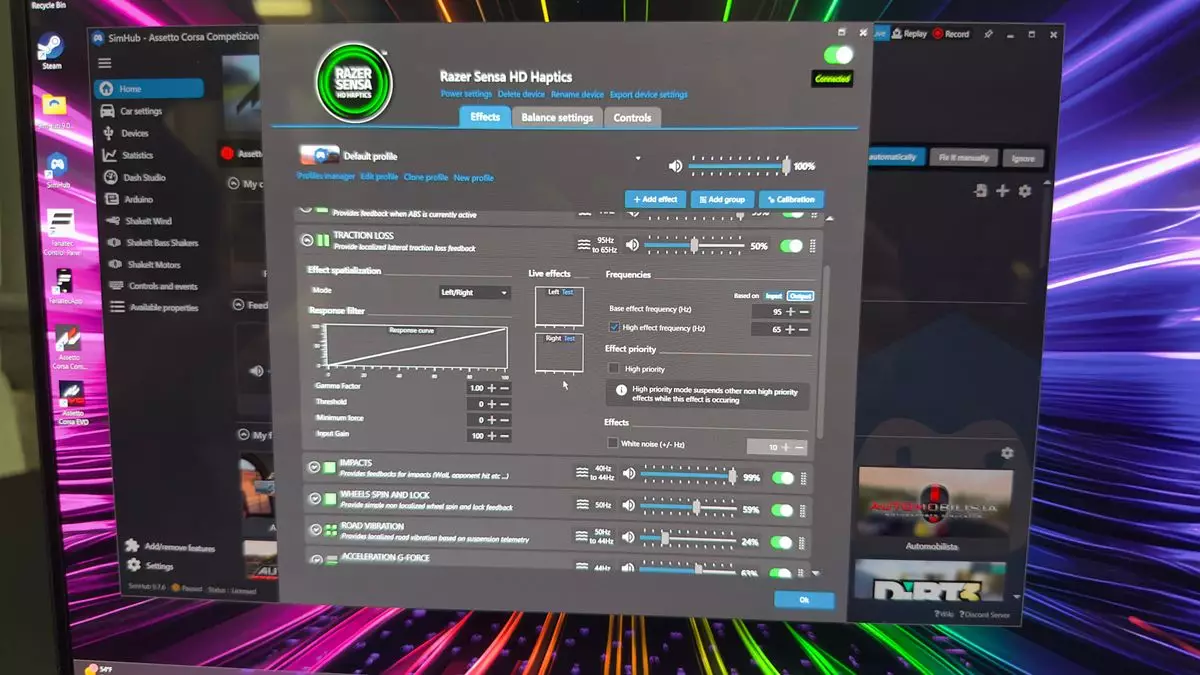In the rapidly evolving world of gaming, peripherals have played a crucial role in enhancing user engagement and immersion. Razer, a prominent name in gaming technology, recently captured the industry’s attention with its innovative offerings—specifically the Freyja seat pad and the Kraken V4 Pro headset. Both integrate haptic feedback technology, aimed at providing gamers with an unprecedented sensory experience. While the Kraken V4 Pro has been praised for its performance, its hefty price tag remains a concern for many consumers. The Freyja, on the other hand, raises an important question: How effective is it in amplifying one’s gaming experience, particularly in an already niche market like sim racing?
Experiencing Haptics in Sim Racing
Having had the opportunity to test both pieces of equipment during a recent industry gathering, it became clear that this technology resonates most with a specific subset of gamers—those passionate about sim racing. The synergistic combination of the Razer Freyja and the Kraken V4 Pro during gameplay in titles like Assetto Corsa Competizione underscores their potential. Utilizing a high-end Razer/Fanatec direct-drive setup, the combination of haptic feedback from the Freyja and the audio immersion from the headset created an engaging and multi-layered experience.
Initially, the vibrations were somewhat distracting, but soon, they transformed into a valuable tool for enhancing gameplay. The haptic technology not only supplemented auditory cues but also allowed for heightened awareness of the vehicle’s dynamics. Gamers could feel the distinct sensations of braking points and tire grip—elements that are crucial in a competitive setting. The newfound ability to distinguish these factors through touch diminished the reliance on sound cues alone, showcasing the potential of haptic feedback to redefine competitive gaming.
Architects of Immersion: The Future of Haptic Integration
The experience raises intriguing possibilities for the future of haptic technology in gaming. Discussions about the potential development of a fully integrated racing seat featuring the Freyja’s technology hint at the ambitions Razer holds. Imagine a racing setup where the seat not only vibrates in response to on-screen action but also simulates cornering forces and acceleration in a more immersive manner. Such innovations could shift the boundaries of competitive gaming, moving closer to a physical embodiment of virtual racing.
Yet, it is essential to acknowledge the challenges that come with these advancements. The sim racing community, while passionate and dedicated, remains relatively small in the larger gaming landscape. Thus, the viability of a product like a premium racing seat with integrated haptic feedback may be limited. The associated high costs could alienate potential customers and hinder widespread adoption. Nevertheless, Razer is not oblivious to the pricing intricacies—it might occupy a middle ground by targeting enthusiasts who are eager for a unique gaming experience without straying too far into the realm of exorbitant pricing.
Razer’s Innovative Software Solutions
In tandem with hardware enhancements, Razer also announced at GDC an integration of its software development kits into a unified platform called Wyvrn, compatible with Unreal Engine 5.5. This integration promises to simplify the development process for future racing titles, ensuring that they harness the full capabilities of Razer’s haptic technology. Developers now have a straightforward pathway to create games that provide users with a rich and immersive experience, fully capitalizing on the innovations of the Freyja and Kraken systems.
While this advancement indicates a bright future for synergy between haptic technology and game development, the present reality brings up another point of contention: Accessibility. As exciting as the prospect of upgraded racing simulations is, the majority of gamers, unfortunately, may find it challenging to access or afford these advanced features.
The Personal Connection to the Experience
During my time using the Freyja and Kraken setup, a bittersweet realization dawned upon me: I lack this exhilarating experience in my personal gaming space. The thrill of racing in such a dynamic environment, surrounded by haptic feedback that truly encapsulates each corner taken and every bump in the track, leaves one yearning for that level of engagement—an engagement that borders on ‘real-life’ as we know it. Yet one must ponder how many could fully embrace such an experience without disruptive distractions from everyday life. Would my cats appreciate my office vibrating at the intensity of a Formula 1 race? It’s a humorous thought, yet a reflection of how technology continues to blur the lines between gaming and reality, challenging us to adapt our spaces to these extraordinary experiences.
As haptic technology continues to evolve, it opens doors to new interactive means by which we engage with our beloved hobby. While Razer’s latest ventures reveal exciting potential, one can’t help but wonder whether the market is ready for such groundbreaking innovations. In the world of gaming, enthusiasm is a powerful force, but accessibility and affordability might dictate if that enthusiasm can translate into widespread adoption.

